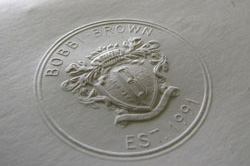> Printing capabilities
Offset
Thermography
Engraving
Embossing>
Foil Stamping
Letterpress
Digital
EMBOSSING
a.k.a. Dimensional printing

Embossing adds dimension to your printed piece, by re-shaping the paper using a specifically crafted die, heat, pressure and a counter. Adding embossing texture and dimension can create an appealing contrast to your design.
Embossing dies are made of magnesium, copper or brass. They can be single level, multi-level or sculpted. Every embossing die requires a counter, which is the male counterpart of the female embossing die. A combination die is a die that can be single level, multi-level or a sculptured die with a relieved background and special counter that allows for foil stamping and embossing in one press pass.
When designing for embossing, for best results use a solid bold stroke, avoiding fine lines and screens.
Paper Considerations
Since embossing produces a dimensional image, the paper used should compliment and not compete with the dimension in the embossed image. As a general rule, smooth stocks lend to embossed designs well.
Variations of Embossing
1. Embossing is where the image is raised up from the surface of the paper.
2. Debossing is where the image is depressed into the paper.
3. Blind embossing is an embossed image in the paper without any ink or foil on the image.
4. Foil embossing is where the image has both foil and embossing.
5. Register embossing is where the embossed image is in register with a printed image.
6. Single level embossing is produced with a single level etched die, typically of magnesium or copper.
7. Multi-level embossing is created with a die that has more than one level of depth, perhaps an emboss and deboss together, typically made from brass.
8. Sculptured embossing is done with a brass die that is either machine tooled or hand engraved to give detail and dimension to an image.